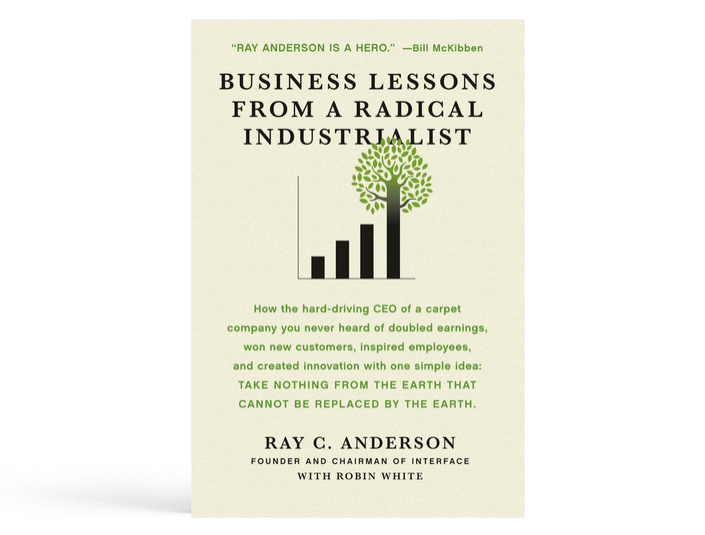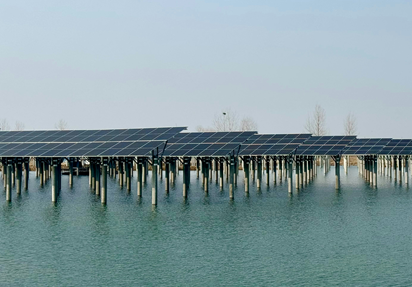Leigh Baker | April 3, 2012
Originally published as “Why? What? How? What Else? A 4MAT interpretation of the Interface “mid course correction”
In a past post, I summarised the 4MAT learning styles model and its application to effective communication. It’s a guide that I use in everything from podcast episodes to writing page copy.
One well-documented regenerative business success story is Ray Anderson’s “BUSINES LESSONS FROM A RADICAL INDUSTRIALIST. How a CEO Doubled Earnings , Inspired Employees and Created Innovation from One Simple Idea” .
In this practical and inspiring handbook (and with help from Robin White) Anderson tells the story of how – from 1996 to 2008 – Interface cut their greenhouse emissions by 71% while doubling their earnings. It’s a great story and a useful way to explore 4MAT as well.
4MAT revisited…
First a quick refresher. The 4MAT model proposes that if you cover the following four points in this specific sequence, you have a better chance of engaging the majority of your audience:
- Why? Imaginative learners need to connect what they’re hearing with prior knowledge and experience. Connect what you’re communicating with their personal meaning system.
- What? Analytic learners want to know the underlying theory and the authorities behind it. Give them information about the facts as experts see them.
- How? Pragmatic learners want to jump in – to get hands on and learn in the doing. Answer the question “How does this work (specifically)?”
- What Else? Dynamic learners learn by doing, and then explore what else they can do with what they’ve learned. Answer the question “What can this become?”
“Why?” elements of the Interface story
This is a story of much more than Corporate Social Responsibility – it’s a story of that gives a very different answer to the question “what is sustainability?” Why did Ray Anderson take on such a major shift in policy and strategy? What elements of his personal meaning systems does he describe?
- Ray was an entrepreneur. He believed that what his customers wanted was important. If they wanted more than compliance then he needed to understand what that was. He had a strong drive to “do it my way”.
- Ray had been trained that “there’s always a better way” during his early engineering studies. He was tuned in to “what else?”
- Ray was moving towards retirement and looking for both a legacy to leave AND a new interest.
- Ray experienced two key understandings from reading the books “The Ecology of Commerce” and “Ishmael”. The first was a deep understanding that “humans can catastrophically change eco-systems”. The second was the challenge issued by Paul Hawken “business is the only group big enough to fix this”
How could you use this to communicate about a sustainability project? Think of someone who you want to influence towards a more regenerative future. Get specific – choose an individual business owner, a business networking group, a professional association. What is their prior knowledge and experience? What are their concerns in life and in business? How could you engage with them?
“What?” elements
What’s the underlying theory and the authorities behind it? What are the facts as experts see them?
- First of all, the fact that’s most surprising to many: Sustainability saves money and makes money. According to Ray Anderson, from 1996 to 2008, Interface cut their greenhouse emissions by 71% while doubling their earnings.
- Interface engaged with a holistic view of sustainability, shifting from a one-way take/make/waste business model to a close loop systems where there are no wastes (only resources) powered by clean, renewable sources of energy. Authorities in this area include Paul Hawken, Amory Lovins, Janine Beynus and Karl-Hendrik Robert amongst many others.
- Interface set a clear, specific goal but no deadline – their objective is to “climb Mount Sustainability” and achieve the goal of “zero footprint”. They borrowed “the goal of zero” from Total Quality Management and extended it.
- Interface went searching for “win/win” solutions where they could save money or make money BY improving their environmental effectiveness. Authorities on win/win business strategies are numerous, and include best-selling authors Jim Collins (Good to Great, Built to Last) and Stephen Covey (The Third Way).
- Interface made the climb part of who they are and what they stand for – a part of their culture that’s the responsibility of everybody. They educated everybody on sustainability, set goals, measured performance, rewarded innovation and published the results.
In designing your sustainability communication, do you have clear statements of “what” the results you want to see are, and references back to the authorities that are behind the results?
“How?” elements
Pragmatic learners want to jump in and do – to get answers to the question “How does this work (specifically)?” So you need specific examples, not just principles.
Here are some specific examples of how Interface engaged their associates in the climb up Mount Sustainability:
- They paid direct incentives to employees who came up with good ideas.
- They developed a holistic evaluation process that included factors such as market presence, reputation and leadership were included alongside costs and ROI calculations.
- They kept score and made sure everybody knew how they were doing and how they compared with other plants.
Interface’s specific strategies and results are many and varied – they’re smart local solutions instead of one-size-fits-all attempts. Some examples include:
- They powered one factory off the methane being produced from a local garbage tip, turning a pollutant into an energy source.
- They switched from printing designs on their carpet to tufting in different yarn colours, making use of existing equipment functionality and completely designing out VOCs.
- They designed carpet surfaces to copy the elegant randomness of a forest floor, reducing installation time and materials waste because there was no need for pattern matching.
- They developed chemical-free ways of securing their carpet, replacing glues containing dangerous VOCs.
- They collaborated with other innovators to develop ways to recover materials from old carpets and turn them into new carpets. They can now divert other manufacturers’ product from landfill and turn it into new carpet.
When you communicate on sustainability, do you include specific, detailed case studies that are relevant to your target audience? Do you include some questions or exercises to encourage listeners to explore what might work in their environment?
“What Else?” elements
Dynamic learners learn by doing, and then explore what else they can do with what they’ve learned. So experiential explorations like “imagine what you might do” will engage them as well as pragmatic learners. Also explore the question “What can this become?” Interface is a fascinating example because they began as a company that turned petro-chemicals into carpet. Their ongoing explorations include:
- Researching how to produce carpet from renewable resources instead of petro-chemicals.
- Reducing the transport impacts of both their products and their people towards zero.
- Exploring the social dimensions of sustainability with workplace safety programs, equal opportunity programs and others both at home and abroad.
- Developing consulting services to leverage what they’ve learned and export their better business model to other industries.
In your communication process, do you include some explorations of how else the ideas you have presented could be applied?
Now it’s your turn
“Business Lessons From A Radical Industrialist” is nearly 300 pages of fascinating reading, so this is just a sampler to explore a single 4MAT application. If you’re into sustainable business then it’s foundation reading. More importantly, if you’re speaking on sustainability then explore how you can maximise the impact of your communication by utilising an understanding of learning styles. Have fun!








